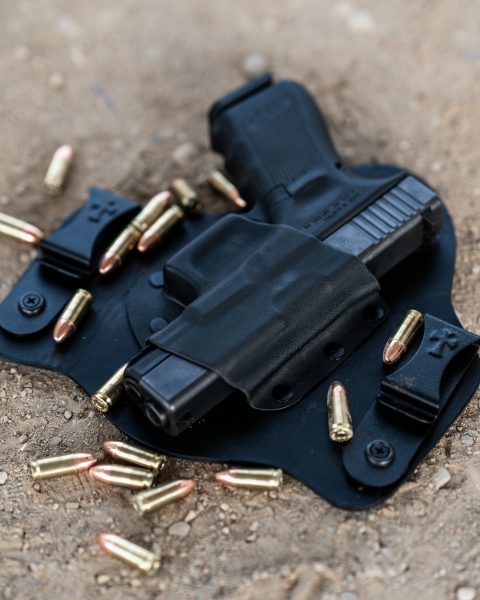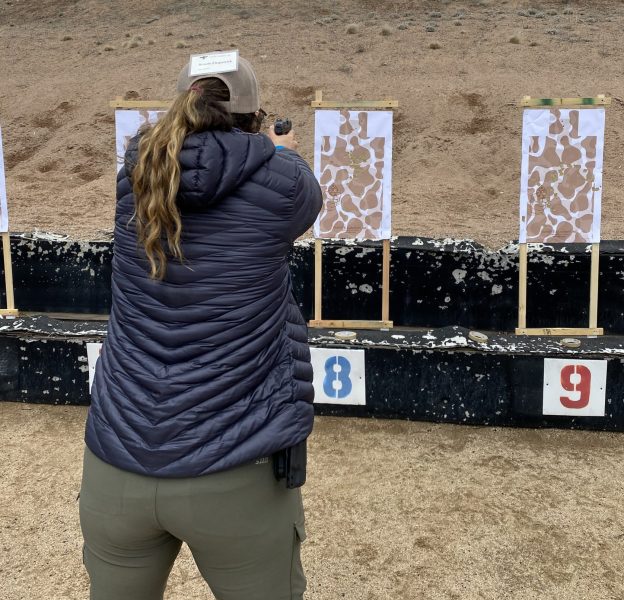Chances are, you have a dominant hand. You’re probably either a righty or a lefty. I say “chances are” because some people are ambidextrous, but that’s less than five percent of the population. Most people are righties, fewer are lefties, and only really special people can use either hand. But I have yet to hear about an ambidextrous viewer, someone who truly sees just as well with either eye. Maybe you’re the one. If so, leave a comment below about your experience.

While it’s true that we typically see the world around us by using both eyes at the same time — thus the 3D effect — some people like to close one eye while shooting. Typically, they close their weak eye to let the strong eye see clearly. The thinking is that by using only their strong eye, they can see the sights better since they are lined up. This does make some logical sense, especially if you’re using a long-range optic on a rifle. If you’re focusing on a target 300 feet away, closing your support eye can help you focus better through the optic, improving your odds of a good shot.
What about when using either iron sights or a red dot, especially on a handgun? Take the long-distance optic away and everything changes. Some long-range shooters do prefer to shoot with both eyes open, but it makes less difference than shooting with a handgun.
Establishing Your Dominant Eye
How do you know which is your dominant eye? If you said it’s the same as your dominant hand, you might be right, but you also might be wrong. Approximately 25% of us are cross-eye dominant, meaning our dominant eye and dominant hand are the opposite. For example, I’m right-handed but left-eye dominant. You might be, too. Let’s find out.

Pick a spot on the wall to focus on. Now bring your hands together to form a triangle hole between them as a viewing port for the item you have in focus. With both eyes open (if you close one eye, it won’t work), slowly bring your hands back toward your eyes with the focused item inside the viewing triangle. When your hands reach your face, they will stop in front of your dominant eye. See how that works?
Another way to check eye dominance is to pick your unloaded and safe gun and, with both eyes open, bring it up on target. Don’t force the gun in front of either eye. It will naturally land in front of your dominant eye. To check it, close each eye separately and see what you see. Your support or weak eye will see down the side of the gun while your dominant or strong eye will see down the sights. The coolest part? You didn’t do anything consciously to make that happen. It’s just the way we are wired.
Real World Application
How does all this eye dominance stuff apply to the real world? If you carry every day, you’re preparing yourself for a time that you might need to use your gun in a defensive shooting. You never want it to happen, but you know it might. If you ever find yourself in a self-defense situation, you’re likely going to react with both eyes open — first assessing the situation, then identifying the potential threat, and finally taking action if appropriate.

Unlike shooting at the range, in the real world, you’ll be in a two-way gun battle. You won’t be facing a static target standing perfectly still and not shooting back at you. Real-world gunfights are dynamic, and the bad guy gets a vote in the outcome. At any point, are you going to shut one eye? Probably not. That would be atypical behavior. Instead, you will likely react with both eyes wide open as you take in the scene and react to the stimulus.
If you decide using your firearm is the appropriate action, your natural reaction will be to bring the gun to bear on the threat with both eyes still open. Should you choose to pull the trigger, it’s doubtful you will close one eye. Most people don’t.
Training for Real Life
The first time you practice shooting with both eyes open, it might feel a bit uncomfortable, like you’re not seeing the target correctly. You might even miss the exact spot on the paper target, but you’ll be close. The more you practice, the more accurate your shots will become. Using a red dot is the same as aiming with standard sights. You will use both eyes in both cases. The only difference is you’re looking at one dot instead a set of sights.

ABOUT THE AUTHOR:

David Workman is an avid gun guy and a contributing writer to several major gun publications. As an NRA-certified instructor, David trains new shooters on basic handgun skills and CCW requirements and is a strong advocate for training as much as possible. “Real-life shootouts don’t happen at a box range.”
![]() You may also enjoy these popular articles:
You may also enjoy these popular articles:




©MTC Holsters, LLC and CrossBreed Holsters Blog, 2022.
Unauthorized use and/or duplication of this material without express and written permission from this site’s author and/or owner is strictly prohibited. Excerpts and links may be used, provided that full and clear credit is given to David Workman and the CrossBreed Blog with appropriate and specific direction to the original content.
![]()


Another way to check for dominant eye. Point at an object across a room with both eyes open. Close one eye at a time while still pointing at said object. With your dominant eye, you will still be pointing at the object. Your non dominant eye, you will be pointing to the side.